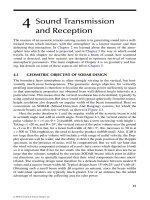Network Fundamentals – Chapter 4 ppt
Bạn đang xem bản rút gọn của tài liệu. Xem và tải ngay bản đầy đủ của tài liệu tại đây (1.66 MB, 47 trang )
© 2006 Cisco Systems, Inc. All rights reserved. Cisco Public
1
OSI Transport Layer
Network Fundamentals – Chapter 4
© 2006 Cisco Systems, Inc. All rights reserved. Cisco Public
2
Objectives
In this chapter, we examine the role of the Transport
layer. The Transport layer also encompasses these
functions:
– Enables multiple applications to communicate over
the network at the same time on a single device
– Ensures that, if required, all the data is received
reliably and in order by the correct application
– Employs error handling mechanisms
Learning Objectives
– Upon completion of this chapter, you will be able to:
– Explain the need for the Transport layer.
– Identify the role of the Transport layer as it provides
the end-to-end transfer of data between applications.
– Describe the role of two TCP/IP Transport layer
protocols: TCP and UDP.
– Explain the key functions of the Transport layer,
including reliability, port addressing, and
segmentation.
– Explain how TCP and UDP each handle key
functions.
– Identify when it is appropriate to use TCP or UDP and
provide examples of applications that use each
protocol.
© 2006 Cisco Systems, Inc. All rights reserved. Cisco Public
3
Purpose of the Transport Layer
The Transport layer provides for the segmentation of data necessary to
reassemble these pieces into the various communication streams.
Its primary responsibilities to accomplish this are:
–Tracking the individual communication between
applications on the source and destination hosts
•Any host may have multiple applications that are communicating
across the network.
•It is the responsibility of the Transport layer to maintain the
multiple communication streams between these applications.
–Segmenting data and managing each piece
•The Transport layer protocols describe services that segment
this data from the Application layer.
•Each piece of application data requires headers at the Transport
layer to indicate to which communication it is associated.
–Reassembling the segments into application data
•At the receiving host, these individual pieces of data must also
be reconstructed into a complete data stream that is useful to the
Application layer.
–Identifying the different applications
•In order to pass data streams to the proper applications, the
Transport layer must identify the target application.
•To accomplish this, the Transport layer assigns an application
an identifier. The TCP/IP protocols call this identifier a port
number.
•Each software process that needs to access the network is
assigned a port number unique in that host.
© 2006 Cisco Systems, Inc. All rights reserved. Cisco Public
4
Purpose of the Transport Layer: link between the layers
The Transport layer is the link between the
Application layer and the lower layer that are
responsible for network transmission.
–This layer accepts data from different conversations
and passes it down to the lower layers as
manageable pieces that can be eventually multiplexed
over the media.
Applications do not need to know the operational
details of the network in use.
–The applications generate data that is sent from one
application to another, without regard to the destination host
type, the type of media over which the data must travel, the
path taken by the data, the congestion on a link, or the size
of the network.
Additionally, the lower layers are not aware that there are
multiple applications sending data on the network.
–Their responsibility is to deliver data to the appropriate
device. The Transport layer then sorts these pieces before
delivering them to the appropriate application.
© 2006 Cisco Systems, Inc. All rights reserved. Cisco Public
5
Transport Layer: multiple Transport layer protocols
Because different applications have different requirements,
there are multiple Transport layer protocols.
–For some applications, segments must arrive in a very specific
sequence in order to be processed successfully.
–In some cases, all of the data must be received for any of it to
be of use.
–In other cases, an application can tolerate some loss of data
during transmission over the network.
The different Transport layer protocols have different rules
to handle these diverse data requirements.
–Some protocols provide just the basic functions for efficiently
delivering the data pieces between the appropriate applications.
•These types of protocols are useful for applications whose data is
sensitive to delays.
–Other Transport layer protocols describe processes that
provide additional features, such as ensuring reliable delivery
between the applications.
•While these additional functions provide robust communication at
the Transport layer, they have additional overhead and make
larger demands on the network.
© 2006 Cisco Systems, Inc. All rights reserved. Cisco Public
6
Transport Layer: Separating Multiple Communications
Consider a computer that is simultaneously receiving and
sending e-mail and instant messages, viewing websites, and
conducting a VoIP phone call.
–Each of these applications is sending and receiving data over the
network at the same time.
–However, data from the phone call is not directed to the web
browser, and text from an instant message does not appear in an e-
mail.
Users require that an e-mail or web page be completely
received for the information to be considered useful.
–Slight delays are considered acceptable to ensure that the
complete information is received and presented.
In contrast, occasionally missing small parts of a telephone
conversation might be considered acceptable.
–This is considered preferable to the delays that would result from
asking the network to manage and resend missing segments.
–One can either infer the missing audio from the context of the
conversation or ask the other person to repeat what they said.
© 2006 Cisco Systems, Inc. All rights reserved. Cisco Public
7
Transport Layer: Dividing data into small parts
As explained in a previous chapter, sending
some types of data - a video for example - across
a network as one complete communication
stream could prevent other communications from
occurring at the same time. It also makes error
recovery and retransmission of damaged data
difficult.
–Segmentation of the data, in accordance with
Transport layer protocols, provides the means to
both send and receive data when running multiple
applications concurrently on a computer.
At the Transport layer, each particular set of
pieces flowing between a source application and
a destination application is known as a
conversation.
–To identify each segment of data, the Transport
layer adds to the piece a header containing binary
data.
–It is the values in these fields that enable different
Transport layer protocols to perform different
functions.
© 2006 Cisco Systems, Inc. All rights reserved. Cisco Public
8
Transport Layer: Controlling the Conversations
The primary functions specified by all Transport layer
protocols include:
–Segmentation and Reassembly
•The Transport layer divides application data into blocks of
data that are an appropriate size.
•At the destination, the Transport layer reassembles the data
before sending it to the destination application or service.
–Conversation Multiplexing
•There may be many applications or services running on each
host in the network.
•Each of these applications is assigned an address known as
a port so that the Transport layer can determine with which
application or service the data is identified.
In addition to the basic functions of data segmentation
and reassembly, some protocols at the Transport layer
provide:
–Connection-oriented conversations
–Reliable delivery
–Ordered data reconstruction
–Flow control
© 2006 Cisco Systems, Inc. All rights reserved. Cisco Public
9
Controlling the Conversations
Establishing a Session
–The Transport layer can provide this connection orientation by
creating a sessions between the applications.
–These connections prepare the applications to communicate with
each other before any data is transmitted.
Reliable Delivery
–For many reasons, it is possible for a piece of data to become
corrupted, or lost completely, as it is transmitted over the network.
–The Transport layer ensure that all pieces reach their destination by
having the source device to retransmit any data that is lost.
Same Order Delivery
–Because networks may provide multiple routes that can have
different transmission times, data can arrive in the wrong order.
–By numbering the segments, the Transport layer can ensure that
these segments are reassembled into the proper order.
Flow Control
–Network hosts have limited resources, such as bandwidth.
–When Transport layer is aware the resources are overtaxed, it can
request the sending application reduce the rate of data flow.
–Flow control can prevent the loss of segments on the network and
avoid the need for retransmission.
© 2006 Cisco Systems, Inc. All rights reserved. Cisco Public
10
Supporting Reliable Communication
However, different applications have different
requirements for their data, and therefore different
Transport protocols have been developed to meet
these requirements.
A Transport layer protocol can implement a method to
ensure reliable delivery of the data. At the Transport
layer the three basic operations of reliability are:
–tracking transmitted data
–acknowledging received data
–retransmitting any unacknowledged data
These reliability processes place additional overhead
on the network resources due to the acknowledgement,
tracking, and retransmission.
To support these reliability operations, more data is
exchanged between the sending and receiving hosts.
–The Transport layer of the receiving host must also track
the data as it is received and acknowledge the receipt of
the data.
© 2006 Cisco Systems, Inc. All rights reserved. Cisco Public
11
Determining the Need for Reliability
At the Transport layer, there are protocols that specify
methods for either reliable, guaranteed delivery or best-effort
delivery.
–In the context of networking, best-effort delivery is referred to as
unreliable, because there is no acknowledgement that the data is
received at the destination.
Applications, such as databases, web pages, and e-mail,
require that all of the sent data arrive at the destination in its
original condition, in order for the data to be useful.
–Therefore, these applications are designed to use a Transport
layer protocol that implements reliability. The additional network
overhead is considered to be required for these applications.
Other applications are more tolerant of the loss of small
amounts of data. For example, if one or two segments of a
video stream fail to arrive, it would only create a momentary
disruption in the stream.
–Imposing overhead to ensure reliability for this application could
reduce the usefulness of the application.
–The image in a streaming video would be greatly degraded if the
destination device had to account for lost data and delay the
stream while waiting for its arrival.
© 2006 Cisco Systems, Inc. All rights reserved. Cisco Public
12
TCP and UDP
The 2 most common Transport layer protocols:
–User Datagram Protocol (UDP)
•UDP is a connectionless protocol, described in RFC 768.
•It providing for low overhead data delivery.
•The pieces of communication in UDP are called datagrams.
•each UDP segment only has 8 bytes of overhead.
•These datagrams are sent as "best effort".
•Applications that use UDP include:
–Domain Name System (DNS)
–Video Streaming
–Voice over IP (VoIP)
–Transmission Control Protocol (TCP)
•TCP is a connection-oriented protocol, described in RFC 793.
•TCP incurs additional overhead to gain functions.
•Additional functions specified by TCP are the same order
delivery, reliable delivery, and flow control.
•Each TCP segment has 20 bytes of overhead in the header
encapsulating the Application layer data,
•Applications that use TCP are:
–Web Browsers
–File Transfers
/>p_stevens/tcp_tran.htm
© 2006 Cisco Systems, Inc. All rights reserved. Cisco Public
13
Port Addressing: Identifying the Conversations
The TCP and UDP based services keep track of the
various applications that are communicating. Both
TCP and UDP have header fields that can uniquely
identify these applications.
–These unique identifiers are the port numbers.
In the header of each segment or datagram, there is a
source and destination port.
–The source port number is the number for this
communication associated with the originating application
on the local host.
–The destination port number is the number for this
communication associated with the destination application
on the remote host.
Port numbers are assigned in various ways,
depending on whether the message is a request or a
response.
–While server processes have static port numbers
assigned to them, clients dynamically choose a port
number for each conversation.
© 2006 Cisco Systems, Inc. All rights reserved. Cisco Public
14
Port Addressing: Identifying the Conversations
When a client application sends a request to a server
application, the destination port contained in the
header is the port number that is assigned to the
service daemon running on the remote host.
–The client software must know what port number is
associated with the server process on the remote host.
–For example, when a web browser application makes a
request to a web server, the browser uses TCP and port
number 80 unless otherwise specified.
The source port in a segment or datagram header of a
client request is randomly generated.
–As long as it does not conflict with other ports in use on
the system, the client can choose any port number
(higher than 1024).
–This port number acts like a return address for the
requesting application.
–The Transport layer keeps track of this port and the
application that initiated the request so that when a
response is returned, it can be forwarded to the correct
application.
© 2006 Cisco Systems, Inc. All rights reserved. Cisco Public
15
Port Addressing: a socket
Socket:
–The combination of the Transport layer port number and
the Network layer IP address assigned to the host
uniquely identifies a particular process running on a
specific host device.
–Occasionally, you may find the terms port number and
socket used interchangeably.
–In the context of this course, the term socket refers only
to the unique combination of IP address and port number.
A socket pair, consisting of the source and destination
IP addresses and port numbers, is also unique and
identifies the conversation between the two hosts.
–For example, an HTTP web page request being sent to
a web server (port 80) running on a host with a Layer 3
IPv4 address of 192.168.1.20 would be destined to
socket 192.168.1.20:80.
–If the web browser requesting the web page is running
on host 192.168.100.48 and the Dynamic port number
assigned to the web browser is 49152, the socket for the
web page would be 192.168.100.48:49152.
© 2006 Cisco Systems, Inc. All rights reserved. Cisco Public
16
The IANA assigns port numbers
Well Known Ports (Numbers 0 to 1023) - These numbers are
reserved for services and applications.
–HTTP (web server) POP3/SMTP (e-mail server) and Telnet.
Registered Ports (Numbers 1024 to 49151) - These port
numbers are assigned to user processes or applications.
–These processes are primarily individual applications that a user
has chosen to install.
–When not used for a server resource, these ports may also be
used dynamically selected by a client as its source port.
Dynamic or Private Ports (Numbers 49152 to 65535) -Also
known as Ephemeral Ports, these are usually assigned
dynamically to client applications when initiating a connection.
–It is not very common for a client to connect to a service using a
Dynamic or Private Port.
Using both TCP and UDP
–Some applications may use both TCP and UDP.
•For example, the low overhead of UDP enables DNS to serve many
client requests very quickly.
•Sometimes, however, sending the requested information may require
the reliability of TCP.
© 2006 Cisco Systems, Inc. All rights reserved. Cisco Public
17
Port Addressing: netstat command
Sometimes it is necessary to know
which active TCP connections are
open and running on a networked
host.
Netstat is an important network utility
that can be used to verify those
connections. Netstat lists:
–the protocol in use,
–the local address and port number,
–the foreign address and port number,
–the state of the connection.
© 2006 Cisco Systems, Inc. All rights reserved. Cisco Public
18
Port Addressing: netstat command
State:
–TIMED_WAIT Client enters this state after active close.
–ESTABLISHED Client received server's SYN and session is
established.
–More: /> Port:
–443: http protocol over TLS/SSL
© 2006 Cisco Systems, Inc. All rights reserved. Cisco Public
19
Segmentation and Reassembly – Divide and Conquer
A previous chapter explained how PDUs are built by
passing data from an application down through the
various protocols to create a PDU that is then
transmitted on the medium.
Some applications transmit large amounts of data - in
some cases, many gigabytes.
–It would be impractical to send all of this data in one
large piece.
–Dividing application data into pieces both ensures that
data is transmitted within the limits of the media and that
data from different applications can be multiplexed on to
the media.
–At the destination host, this process is reversed until the
data can be passed up to the application.
TCP and UDP Handle Segmentation Differently.
–In TCP, each segment header contains a sequence
number. This sequence number allows the Transport
layer functions on the destination host to reassemble
segments in the order in which they were transmitted.
–In UDP header, there is no sequence number. UDP is a
simpler design and generates less overhead than TCP,
resulting in a faster transfer of data.
© 2006 Cisco Systems, Inc. All rights reserved. Cisco Public
20
TCP-Making Conversations Reliable
The key distinction between TCP and UDP is reliability.
The reliability of TCP communication is performed using
connection-oriented sessions. (3 way handshake)
–Before a host using TCP sends data to another host, the
Transport layer initiates a process to create a connection with the
destination.
–This process ensures that each host is aware of and prepared for
the communication.
After a session has been established (3 way handshake),
the destination sends acknowledgements to the source for
the segments that it receives.
–As the source receives an acknowledgement, it knows that the
data has been successfully delivered and can quit tracking that
data.
If the source does not receive an acknowledgement within a
predetermined amount of time, it retransmits that data to the
destination.
–There is also additional overhead on the individual hosts created
by the necessity to keep track of which segments are awaiting
acknowledgement and by the retransmission process.
© 2006 Cisco Systems, Inc. All rights reserved. Cisco Public
21
TCP Server Processes
It is common for a server to provide more than one
service, such as a web server and an FTP server, at
the same time.
Each application process running on the server is
configured to use a port number, either by default or
manually by a system administrator.
–An individual server cannot have two services assigned
to the same port number within the same Transport layer
services.
•A host running a web server application and a file transfer
application cannot have both configured to use the same port.
–When an active server application is assigned to a
specific port, that port is considered to be "open" on the
server.
•Any incoming client request addressed to the correct socket
is accepted and the data is passed to the server application.
–One way to improve security on a server is to restrict
server access to only those ports associated with the
services and applications that should be accessible to
authorized requestors.
© 2006 Cisco Systems, Inc. All rights reserved. Cisco Public
22
Extra information: Proxy Server
:8080/web1
:8080/web2
:8080/web3
•In computer networks, a proxy server is a server (a computer system or
an application program) which services the requests of its clients by
forwarding requests to other servers.
•A listener is a port on the Internet Security and Acceleration (ISA) server
that is listening for TCP (transmission control protocol) connections.
•ISA server is configured by default to listen on port 8080
•Using proxy setting with browser.
© 2006 Cisco Systems, Inc. All rights reserved. Cisco Public
23
Extra information: Proxy client with port 8080
•hard coded proxy setting within their Internet explorer browser.
© 2006 Cisco Systems, Inc. All rights reserved. Cisco Public
24
TCP Connection Establishment and Termination
When two hosts communicate using TCP:
–a connection is established before data can be
exchanged.
–The host tracks each data segment within a session and
exchanges information about what data is received.
–After the communication is completed, the sessions are
closed and the connection is terminated.
To establish the connection, the hosts perform a
three-way handshake.
–Establishes that the destination device is present on the
network
–Verifies that the destination device has an active service
and is accepting requests on the destination port number
that the initiating client intends to use for the session
–Informs the destination device that the source client
intends to establish a communication session on that port
number
© 2006 Cisco Systems, Inc. All rights reserved. Cisco Public
25
TCP Connection Establishment: Three-way Handshake
The three steps in TCP connection establishment
are:
–1. The initiating client sends a segment containing
an initial sequence value, which serves as a request
to the server to begin a communications session.
–2. The server responds with a segment containing
an acknowledgement value equal to the received
sequence value plus 1, plus its own synchronizing
sequence value.
•The value is one greater than the sequence number
because the ACK is always the next expected Byte or
Octet.
•This acknowledgement value enables the client to tie
the response back to the original segment that it sent to
the server.
–3. Initiating client responds with an
acknowledgement value equal to the sequence value
it received plus one. This completes the process of
establishing the connection.









